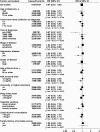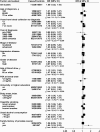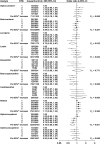Carotenoids, retinol, tocopherols, and prostate cancer risk: pooled analysis of 15 studies
- PMID: 26447150
- PMCID: PMC4625592
- DOI: 10.3945/ajcn.115.114306
Carotenoids, retinol, tocopherols, and prostate cancer risk: pooled analysis of 15 studies
Abstract
Background: Individual studies have suggested that circulating carotenoids, retinol, or tocopherols may be associated with prostate cancer risk, but the studies have not been large enough to provide precise estimates of associations, particularly by stage and grade of disease.
Objective: The objective of this study was to conduct a pooled analysis of the associations of the concentrations of 7 carotenoids, retinol, α-tocopherol, and γ-tocopherol with risk of prostate cancer and to describe whether any associations differ by stage or grade of the disease or other factors.
Design: Principal investigators of prospective studies provided individual participant data for prostate cancer cases and controls. Risk by study-specific fifths of each biomarker was estimated by using multivariable-adjusted conditional logistic regression in matched case-control sets.
Results: Data were available for up to 11,239 cases (including 1654 advanced stage and 1741 aggressive) and 18,541 controls from 15 studies. Lycopene was not associated with overall risk of prostate cancer, but there was statistically significant heterogeneity by stage of disease, and the OR for aggressive disease for the highest compared with the lowest fifth of lycopene was 0.65 (95% CI: 0.46, 0.91; P-trend = 0.032). No other carotenoid was significantly associated with overall risk of prostate cancer or with risk of advanced-stage or aggressive disease. For retinol, the OR for the highest compared with the lowest fifth was 1.13 (95% CI: 1.04, 1.22; P-trend = 0.015). For α-tocopherol, the OR for the highest compared with the lowest fifth was 0.86 (95% CI: 0.78, 0.94; P-trend < 0.001), with significant heterogeneity by stage of disease; the OR for aggressive prostate cancer was 0.74 (95% CI: 0.59, 0.92; P-trend = 0.001). γ-Tocopherol was not associated with risk.
Conclusions: Overall prostate cancer risk was positively associated with retinol and inversely associated with α-tocopherol, and risk of aggressive prostate cancer was inversely associated with lycopene and α-tocopherol. Whether these associations reflect causal relations is unclear.
Keywords: biomarkers; carotenoids; nested case-control study; pooled analysis; prostate cancer; retinol; tocopherols; vitamin A; vitamin E.
© 2015 American Society for Nutrition.
Figures





References
-
- Chan JM, Gann PH, Giovannucci EL. Role of diet in prostate cancer development and progression. J Clin Oncol 2005;23:8152–60. - PubMed
-
- Krinsky NI, Johnson EJ. Carotenoid actions and their relation to health and disease. Mol Aspects Med 2005;26:459–516. - PubMed
-
- O’Neill ME, Carroll Y, Corridan B, Olmedilla B, Granado F, Blanco I, Van den Berg H, Hininger I, Rousell AM, Chopra M, et al. . A European carotenoid database to assess carotenoid intakes and its use in a five-country comparative study. Br J Nutr 2001;85:499–507. - PubMed
-
- Schlatterer J, Breithaupt DE. Xanthophylls in commercial egg yolks: quantification and identification by HPLC and LC-(APCI)MS using a C30 phase. J Agric Food Chem 2006;54:2267–73. - PubMed
-
- McKevith B. Is salmon salmon pink? The use of canthaxanthin in animal feeds. Nutr Bull 2003;28:243–5.
Publication types
MeSH terms
Substances
Grants and funding
- 16491/CRUK_/Cancer Research UK/United Kingdom
- U10 CA037429/CA/NCI NIH HHS/United States
- P01 CA108964/CA/NCI NIH HHS/United States
- G1000143/MRC_/Medical Research Council/United Kingdom
- CA37429/CA/NCI NIH HHS/United States
- N01-RC-37004/RC/CCR NIH HHS/United States
- C570/A11691/CRUK_/Cancer Research UK/United Kingdom
- 19170/CRUK_/Cancer Research UK/United Kingdom
- CA 55075/CA/NCI NIH HHS/United States
- 15194/CRUK_/Cancer Research UK/United Kingdom
- C8221/A19170/CRUK_/Cancer Research UK/United Kingdom
- N01-RC-45035/RC/CCR NIH HHS/United States
- 1-UM1-CA164973/CA/NCI NIH HHS/United States
- P30 CA015704/CA/NCI NIH HHS/United States
- U01 CA63673/CA/NCI NIH HHS/United States
- UG1 CA189974/CA/NCI NIH HHS/United States
- 14136/CRUK_/Cancer Research UK/United Kingdom
- HHSN261201000006C/CP/NCI NIH HHS/United States
- R01CA96789/CA/NCI NIH HHS/United States
- G0401527/MRC_/Medical Research Council/United Kingdom
- N01-CN-45165/CN/NCI NIH HHS/United States
- CA 94028/CA/NCI NIH HHS/United States
- CA 72036/CA/NCI NIH HHS/United States
- P01 CA 33619/CA/NCI NIH HHS/United States
- N01 PC35142/PC/NCI NIH HHS/United States
- UM1 CA182883/CA/NCI NIH HHS/United States
- UM1 CA167462/CA/NCI NIH HHS/United States
- 001/WHO_/World Health Organization/International
- U01 CA164973/CA/NCI NIH HHS/United States
- R37 CA 54281/CA/NCI NIH HHS/United States
LinkOut - more resources
Full Text Sources
Other Literature Sources
Medical

